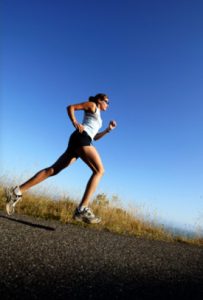Summer is in full-swing and with that comes increasingly hot temperatures; high humidity in many parts of the country, and of course, the transition from indoor workout programs to outdoor warm or hot weather programs. While it’s great to get outside and enjoy the summer heat while you’re working out, it can also be dangerous. According to the USPHS, as the temperatures rise, so does the incidence of environmental heat-related exertional illnesses. The better you can understand heat illnesses, their preventative measures, and what treatment options there are, the safer you will be when you work out outdoors. Below we’ll go over some tips and tricks that fitness experts, as well as those with their personal trainer certification recommend if you’re hitting the outdoors this summer.
When you’re deciding what time of day is best for your workout, it really is best to do everything you can do to get your exercise in when the midday sun isn’t shining. Schedule your work out for before 10am or after 6pm, if possible.
Rest and recover
When you’re exercising in high heat and humidity, it’s imperative that you get the right amount of rest. For every hour that you work out, rest for 10 minutes. And, if your clothes are wet, change them frequently.
Sunscreen is a MUST
When working out outdoors in the summer sun, you should always be sure to wear sunscreen. Use sunscreen that is SPF-15 or lower. If you use a sunscreen that is higher than SPF-15, it can interfere with your skin’s thermal regulation.
Hydrate and re-hydrate
You should weigh yourself pre and post exercise. If there is less than a two percent weight loss between pre and post exercise, you are considered mildly dehydrated. If there is greater than two percent weight loss, then you are considered dehydrated. Be conscious of your water intake and if you feel dizzy or light-headed, rest for a few minutes. During hot weather training, dehydration can occur more frequently and have more severe consequences. When rehydrating, it isn’t recommended that you utilize rapid fluid replacement. Rapid fluid replacement stimulates increased urine production, which reduces water retention. After bouts of exercise that last longer than an hour, replace your fluids at a rate of 16 ounces of fluid per pound of body weight lost during exercise.
Know your definitions
No, not your muscle definition. You should know what weather-related terms mean for hot weather. Things like the Steadman or Heat Index are a good start. You should always check the heat index before you work out. Heat illness, heat cramps, heat syncope, heat exhaustion, exertional heat stroke, exercise induced hyponatremia, and others are also great to brush up on. Knowing what these phrases are, what the signs and symptoms are, and how to prevent them will go a long way towards keeping you safe during outdoor warm-weather work outs.
Be educated and take the advice by those with personal trainer certification when it comes to working out in hot weather. It could save your life.



